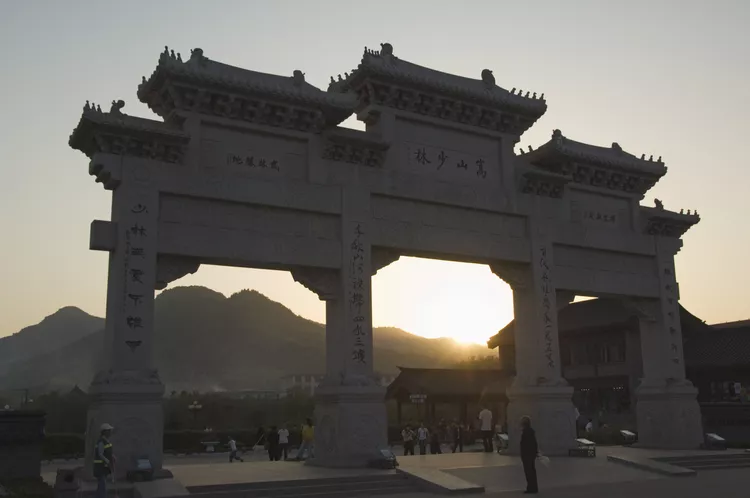1. Summary
It is said that a Buddhist monk from India named Buddhabhadra, or Ba Tuo in Chinese, came to China during Emperor Xiaowen’s reign during the Northern Wei Dynasty period in 495AD. The emperor was impressed by Buddhabhadra and offered support for teaching Buddhism at court. Nevertheless, Buddhabhadra declined and was granted land to establish a temple on Mt. Song. Thus, he constructed Shaolin, which translates to “small forest.”
Zen Buddhism Comes to Shaolin Temple
Thirty years after the founding of Shaolin, another Indian monk named Bodhidharma arrived in China to impart Yogic concentration, now commonly recognized as “Zen” Buddhism in Japanese culture. His travels led him to Mt. Song, where he sought admission to Shaolin Temple.
A Monk Meditates for Nine Years
The abbot, Fang Chang, initially refused Bodhidharma’s entrance. Consequently, Bodhidharma retreated to the mountains, taking refuge in a cave where he meditated for nine years. It is said he faced the cave wall so intensely that his shadow became permanently imprinted there. Presently, this cave is revered as a sacred site, and the shadow imprint has been moved to the temple compound for visitors to see—a truly remarkable sight.
Finally, after nine long years, Fang Chang granted Bodhidharma access to Shaolin, where he became the First Patriarch of Zen Buddhism.
The Origins of Shaolin Martial Arts or Kung Fu
Legend has it that Bodhidharma exercised in the cave to maintain his fitness. Upon arriving at Shaolin Temple, he discovered the monks were not well-conditioned. Therefore, he devised a set of exercises that laid the groundwork for the unique style of martial arts practiced at Shaolin. Acknowledging that martial arts were already popular in China, especially among former soldiers, Bodhidharma’s teachings merged with existing martial arts to create the Shaolin interpretation of Kung Fu.

Warrior Monks
Initially intended for exercise, Kung Fu later became essential for defending against intruders attempting to seize the monastery’s possessions. Consequently, Shaolin gained a reputation for its warrior monks, who became exceptional in the practice of Kung Fu. Despite their formidable skills, these monks adhered to strict martial ethics, known as wude, which prohibited behaviors such as “betraying your teacher” and “fighting for trivial matters,” as well as delineating eight “hit” and “do not hit” zones to minimize harm to opponents.
Buddhism Banned
Shortly after Bodhidharma’s admission to Shaolin, Emperor Wudi imposed a ban on Buddhism in 574AD, resulting in the destruction of the Shaolin Temple. However, later in the Northern Zhou Dynasty, Emperor Jingwen revived Buddhism, leading to the reconstruction and restoration of Shaolin.
Shaolin’s Golden Era: Warrior Monks Save Tang Dynasty Emperor
During the early Tang Dynasty (618-907), a group of thirteen warrior monks aided the Tang emperor in rescuing his son, Li Shimin, from an army seeking to overthrow the dynasty. In gratitude for their bravery, once he became emperor, Li Shimin honored Shaolin as the “Supreme Temple” across China, promoting an exchange of knowledge and martial arts between the imperial court and the Shaolin monks. This sparked a flourishing development of Shaolin Temple’s martial arts for several centuries until it became a refuge for Ming loyalists.
The Decline of Shaolin
As a sanctuary for Ming loyalists, Shaolin Temple faced devastation when Qing rulers razed it to the ground, destroying many priceless artifacts and sacred texts. Consequently, Shaolin Kung Fu was prohibited, and the remaining monks scattered across China, adhering to the teachings of Shaolin in lesser temples. Although Shaolin reopened a century later, mistrust towards its martial arts persisted, leading to recurrent periods of burning and rebuilding across centuries.

Present-day Shaolin Temple
Currently, Shaolin Temple functions as an active Buddhist site, where contemporary interpretations of the original Shaolin Kung Fu are practiced. Some sources indicate that the original style was considered too potent and was subsequently replaced by Wu Shu, which is a more moderate form of martial arts. Regardless of the practice today, Shaolin Temple remains a hub of dedication and learning, as evidenced by the hundreds of youngsters practicing outside every morning. There are now over eighty Kung Fu schools around Mt. Song in Dengfeng, where thousands of Chinese children begin their training as early as five years old. Shaolin Temple and its teachings continue to impress visitors.





